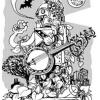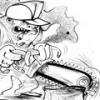We humans get too caught up in the world. Take Elvis Presley, for example. I can’t say for certain, but I’m pretty sure Elvis would’ve been satisfied with his git-fiddle, one or two hit singles, and his good gal. Instead, they handed him the free world… which then proceeded to devour him like he was a three-cheese Hot Pocket. So it goes. Sometimes artists get famous and make a lot of money. Usually, they don’t. Either way, it’s commonly agreed that an artist should pretty well know how to function and be happy without the recognition and validation of the public eye. We all know this, of course, but history tells us that the sweet fruits of selling out are hard to resist. It’s for this reason, I suppose, that we tend to favor those artists who labor in obscurity their whole lives. We like knowing that our artists are for real, and not just in it for the loot, groupies or hero worship. (Being an “American Idol,” after all, is a cinch compared to being Emily Dickinson.)
It’s easy to see that while Americans might carry the reputation for being greedy and materialistic, we somehow manage to keep the image of the renunciant ascetic at the center of our cultural shrine. Some might say this paradox is emblematic of a national pathology, a kind of Jekyll & Hyde split of the psyche. Maybe so, but somewhere within that paradox, navigating the endless hairpin turns, dead ends and crossroads, you’ll find every American artist who ever lived – including a strange one from middle Georgia named Eddie Owens Martin.
Who?

If you haven’t heard that name before, well, suffice it to say that he’s just about the weirdest cat you never met – so weird he refused to be airbrushed, alloyed, snow-jobbed or beaten into conformity by the forces of authority that get to most of us early on. So bizarre that he took to the open road rather than subject himself to the tyranny of a cruel and oppressive father. So eccentric that when he finally settled down, he tried to make a homestead for himself that suited him and embodied his highest ideals… pretty sane and sound-minded, in other words. Of course, I haven’t gotten to the part about his bizarre “visions” or his eccentric beliefs yet, but it doesn’t matter. However eccentric Eddie Owens Martin might’ve been, the fact remains that his natural responses to this world gone wrong are among the more brave and artful that you’ll ever likely come across. His personal story and life’s work, inextricably intertwined, stand as a perfect example of Southern ingenuity and élan. What’s more, his magnum opus, Pasaquan, is – I promise you – the most poignant and stunning thing you’ll hear about this year.
Eddie Owens Martin was born into a world of pain and poverty in 1908. His parents, Lydia Pearl and Julius, were Georgia crackers from Marion County. They were cotton and sugarcane sharecroppers who worked a meager subsistence out of red clay. Eddie was a thoughtful child, though he loved adventure and was fascinated by people – regardless of what side of the tracks they were from. The way he saw it, the more colorful the better. But by all accounts, Julius Martin was a cruel and physically abusive man who didn’t exactly prize his son’s natural curiosity and introspection. By the time young Eddie reached the age of 14, he had seen enough hard times and violence to know that he’d better get out of Dodge while he still could. So he did, saving both his hide and spirit, and hauling them both North, into the great wide open. He was still only a kid, but he had already learned what he needed to know: The world is a marvelous enough place, but it can sure be hard and mean.
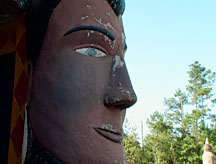
Eddie Own Martin’s travels landed him in New York City. Unfettered at last, he loosed himself upon the city’s museums, libraries and art houses. He explored ancient cultures, mythology and world religion. Meanwhile, he painted, sculpted and studied art. He walked on the Wild Side, too, and dressed in drag, often sporting flamboyant garments he had stitched together himself. Martin juked, jived, appropriated and survived, scratching out a new home for himself in Bohemian America. Somewhere along the line, he even learned to read palms and tell fortunes. It was a good hustle. (Or was it? He certainly knew how to make ends meet, but there’s enough reason to believe that Martin was a bona fide future-seer. He had a steady stream of dedicated clients, after all, in a field where repeat business depends largely upon predictive accuracy.) His natural interest in the occult found expression in New York as well, foreshadowing a most peculiar string of trances and visions – visions that would inform, inspire and, at times, plainly dictate Martin’s artwork and way of life.
St. Eom
Martin’s first vision came on strong, some time in the late 1930s. He was still raking and scraping in New York, but had become bedridden with the flu. His illness dragged on for days. And then it happened. Feverish and sickly, with beads of sweat on his brow, Martin quietly slipped beyond the veil and found himself in the presence of three giant otherworldlies. They explained that they were visitors from a futuristic realm known as “Pasaquan,” and that their intention was to help ease humanity’s suffering. Martin was to be their chief diplomat, a medium between consensual reality and the world of Pasaquan. The visitors, who called themselves “Pasaquoyans,” then bestowed upon Martin a new name, one that would reflect his budding vocation. From then on he would be known as “St. Eom,” pronounced “Saint AUM,” as in the sacred Sanskrit mantra chanted by Hindus and Buddhists the world over.
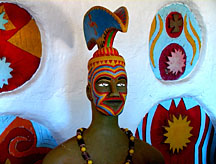
For Eddie Owens Martin, this event must have been what’s called a “peak experience”- a spiritual high point in one’s life that gives meaning and order to everything that has preceded, as well as all that is to follow. This is an important point, because modern psychology tends to regard sacred visions as such with much skepticism – and with good reason. After all, there’s a fine line between “vision” and “hallucination” or “delusion,” especially when you add up the facts that Martin was a hipster of the highest order, known to enjoy his fair share of cannabis, and who also happened to be in the throes of a high fever when his visions first came on. Now, hallucinations are common in fevered states. And we all know that, with heavy and prolonged use, marijuana definitely has the capacity to crack open an astral plane or two. But I’d like to offer another take on these visions, one that doesn’t confine St. Eom to the realms of lunatic, addict, charlatan or fool. Rather, I’d like to suggest the possibility that what happened to Martin that day was the Real Deal, a shamanic experience right down to the bone – an honest-to-God brush with supernatural forces.
Time went on and St. Eom continued to experience periodic visitations from the Pasaquoyans. He began depicting them in his artwork as well – scores of paintings, drawings and sculptures. In every one, they appear bronze-skinned, beatific, sometimes bearded, and always with a serene countenance. Harboring no apparent shame about their physical form, St. Eom’s Pasaquoyans are often naked, though, sure enough, they’re sometimes clad in turbans or high-tech Pasaquoyan magnetic jumpsuits meant to enable teleportation, levitation and chakra attunement. (These same accouterments also became standard adornments for St. Eom, whose “RuPaul meets Yaqui medicine man” style shocked, impressed and sometimes frightened passersby.) Whether they were figments of his fertile imagination or entities from another astral plane, it was the Pasaquoyans whom St. Eom clearly sought to emulate. And it was the Pasaquoyans who instructed him to return to Georgia and build his very own Pasaquan in Marion County. St. Eom did just that, too. He worked on Pasaquan for the next 30-odd years, right up until around noon of Apr. 16, 1986, when Eddie Owens Martin drew his .38 and shot himself through the head. He was 77 years old.
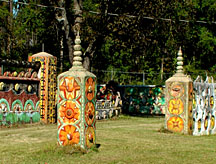
What St. Eom left behind is something that can scarcely be described. One of Georgia’s rare and stunning roadside attractions, Pasaquan is a prodigious, sprawling, unfinished work of art; a Day-Glo spectacle of hand-crafted effigies, murals, sculptures, sentinels and totems; an architectural collage of sacred art, occult symbolism, personal material and pop imagery. The place sits on seven acres of land, and is comprised largely of concrete walls and sculptures that tie into various other structures, one of which is an old farm house that St. Eom’s mother once called home. There’s also a beadwork suite, a sacred dance circle, a sweat lodge, a meditation nook, some studio space, a place for St. Eom to make some cash by telling fortunes and a cool, dry room that must’ve been just about perfect for drying, cutting and cleaning an endless stash of homegrown Marion County ganja.
A cross-cultural thing of weird beauty plopped down in the middle of red clay and pine tree scrublands, Pasaquan looks like it lurched straight out of the Collective Unconscious and sat itself down on Georgia Highway 137. It is home to a wild collection of archetypes – suns, moons, serpents, mandalas, genitalia, spaceships, yin-yangs, severed heads, lost continents and bodhisattvas – all forged in concrete, dipped in Technicolor, adorned in hammered aluminum, then left to dry in the blistering hot sun of South Georgia. Like St. Eom himself sauntering down a boulevard, Pasaquan defies casual observation. It can’t be digested in a quick glance, or even an entire afternoon. To wit: recently, during a visit to Pasaquan, I watched a group of bewildered tourists drive up in an Econoline van. They parked and got out. Staring out across Pasaquan, I heard one of ‘em ask “Mama, what is this?!” A kind of Paradise, really, is what it is.
Fading
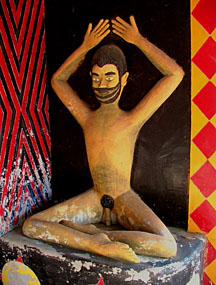
Lucky for us, the Pasaquan Preservation Society opens Pasaquan up to the public from time to time. They give tours and, since some of the members of the Society knew St. Eom personally, can even spin a yarn or two about him. I highly recommend this experience. From Athens, it’s a three-hour drive – which is a bit of a haul, sure, but still a day trip. That three-hour drive, you’ll find, is well worth it, too. After all, St. Eom was the Real Deal Renunciant Artist. And in a world where anything bona fide or worth a damn seems to be endangered or already extinct, it’s on us to seek out what’s good and real, and maybe toss some change into that bucket over there by the door. It could change your life. Personally, I believe The Gods smile on those who give alms. But maybe I’m wrong. Maybe it’s the Pasaquoyans.
Pasaquan is located off Hwy. 137, just northwest of Buena Vista, GA. It will be open to the public for one Saturday each month from April through November of this year, beginning on Saturday, Apr. 7. Visit the Pasaquan Preservation Society at www.pasaquan.com for a full schedule and more information.
Like what you just read? Support Flagpole by making a donation today. Every dollar you give helps fund our ongoing mission to provide Athens with quality, independent journalism.







